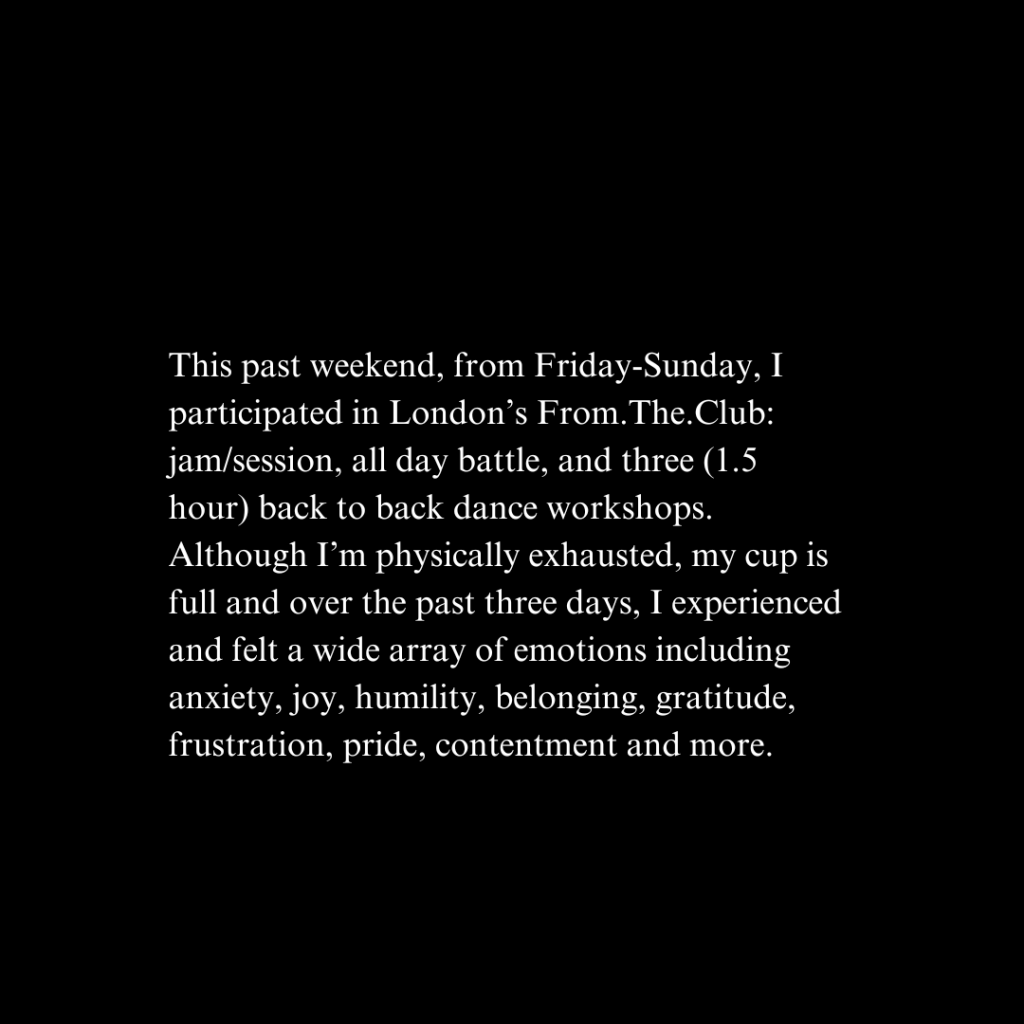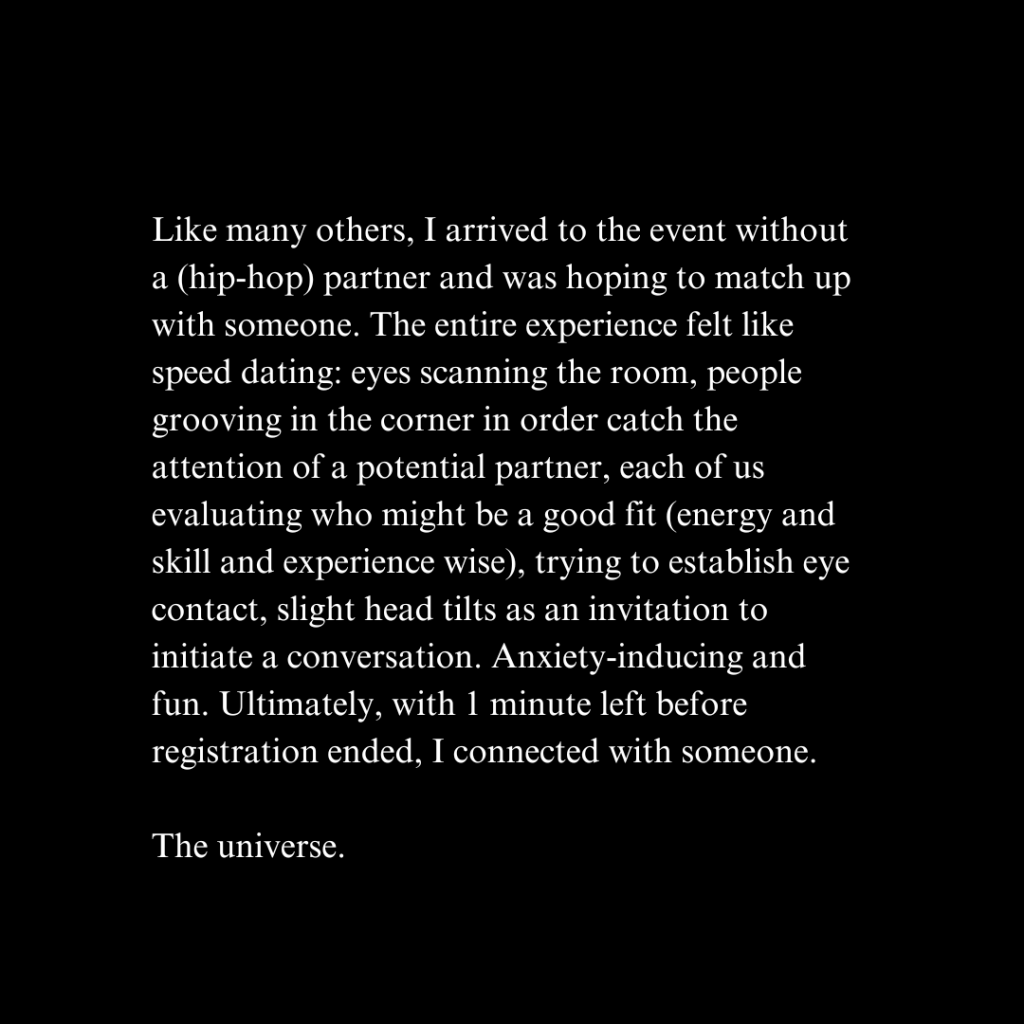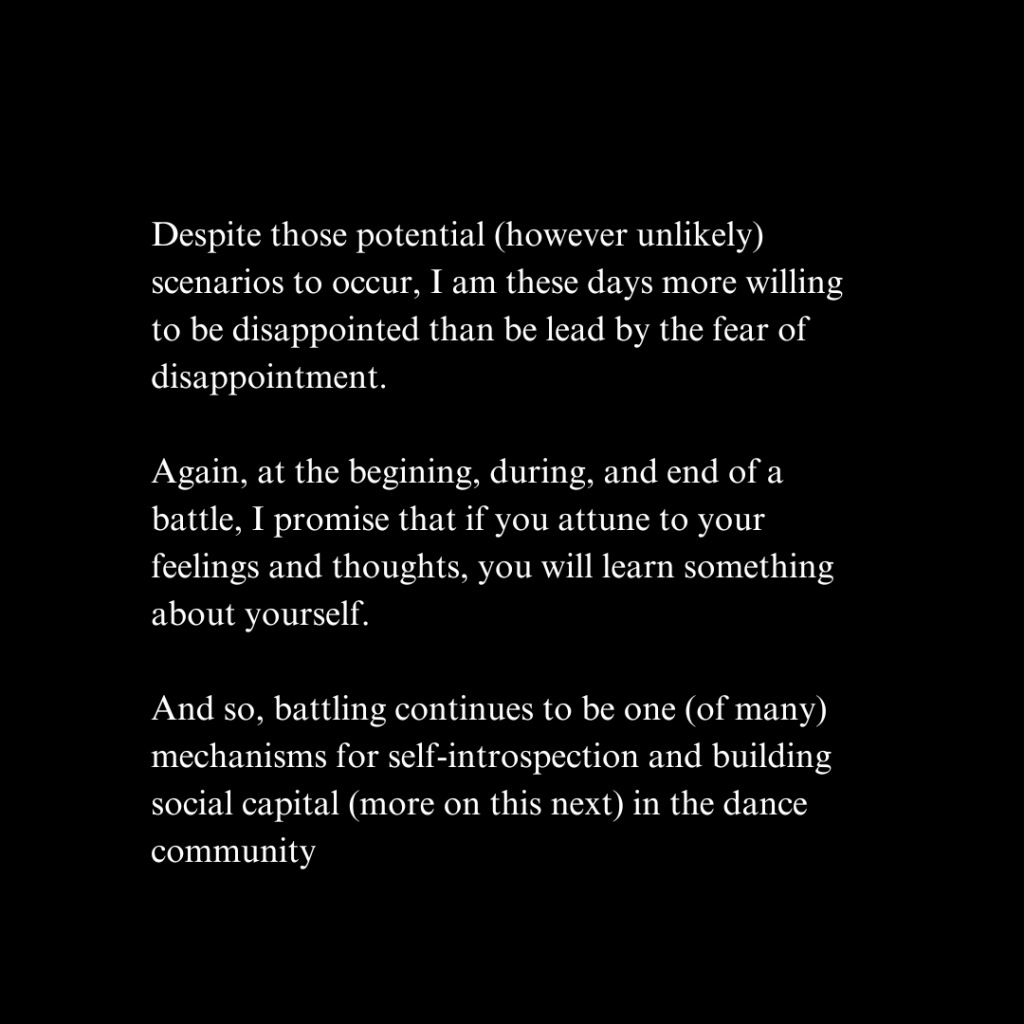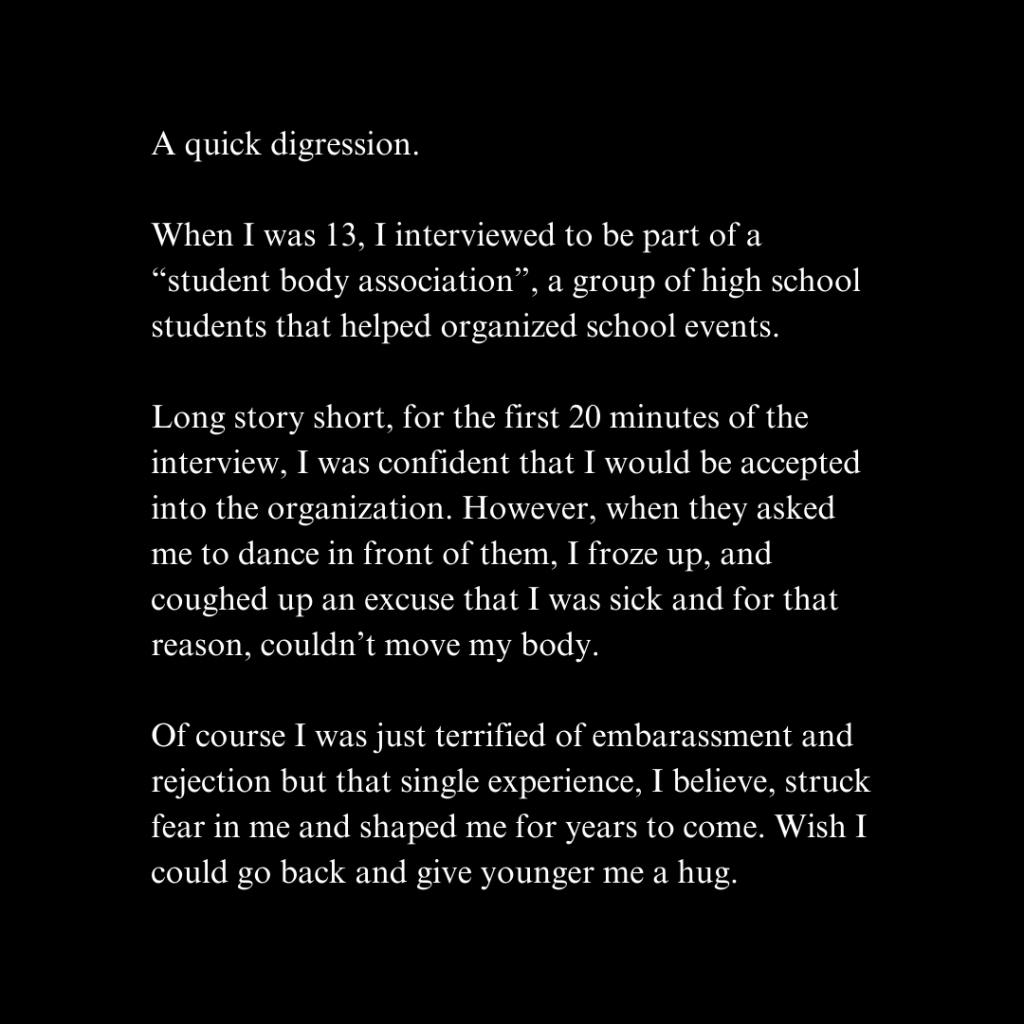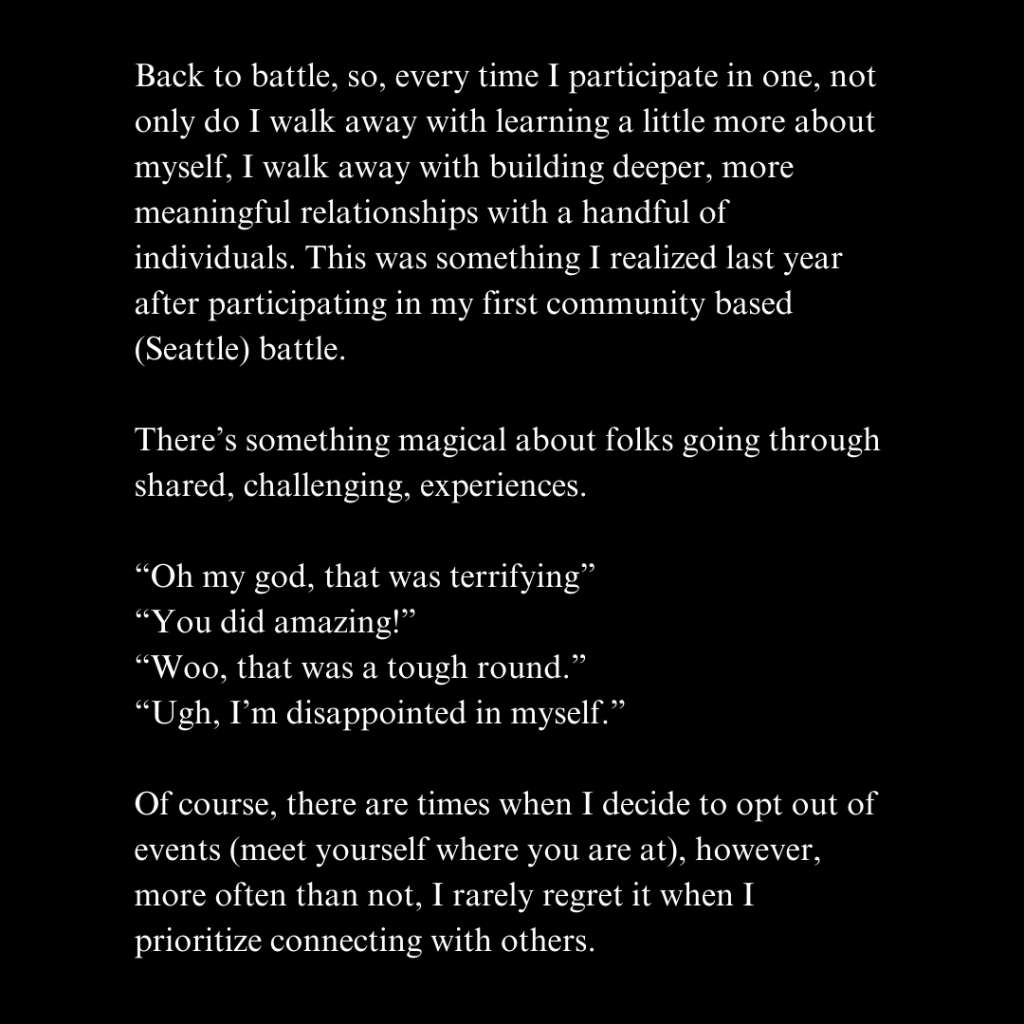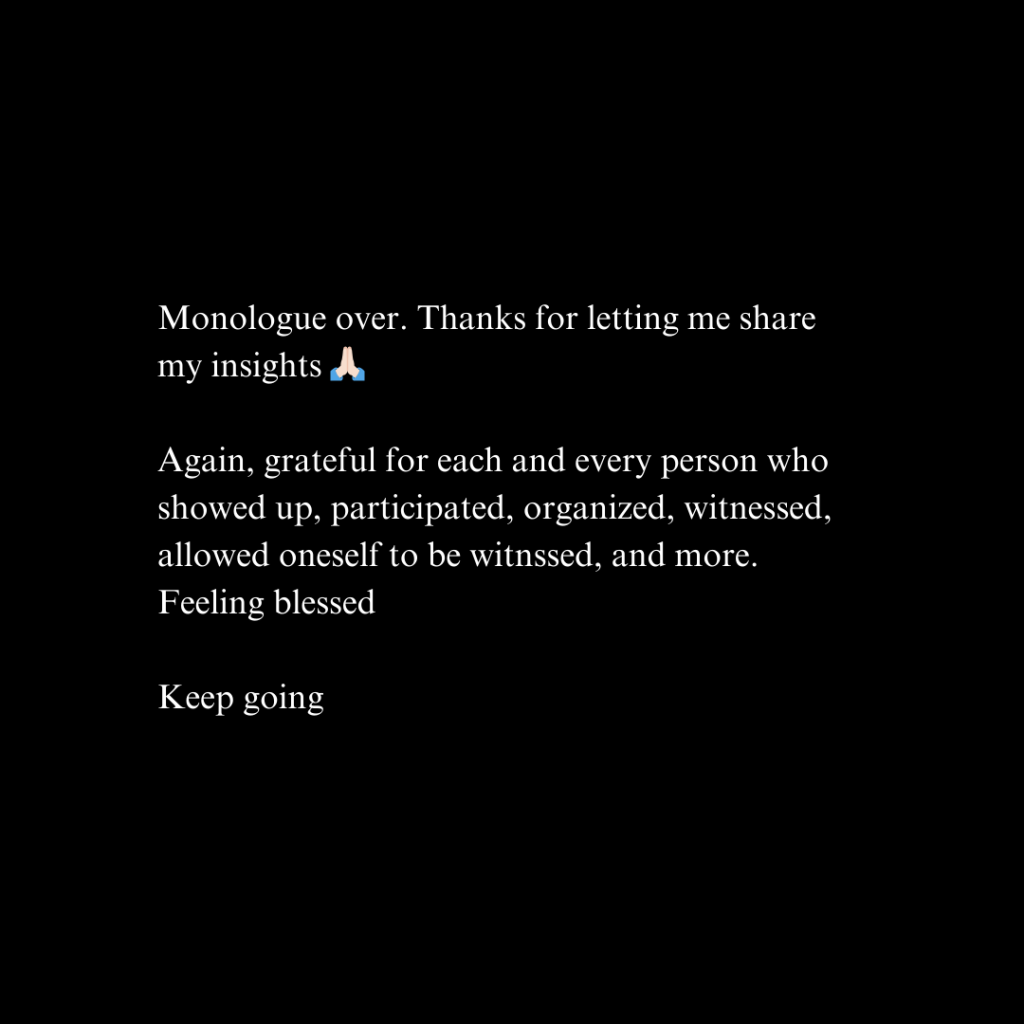Like many others, I watch and study lots of house dance videos. I’m still very much a beginner when it comes to the craft — at the time of this writing, about 14 months into the journey — however I’m noticing an increased ability within myself to tease out what highly skilled dancers are trying to convey in their rounds. Because I recently started training privately with Mavinga, I’m leveraging the opportunity by attempting to analyzing her videos and then coming up with questions that I can ask her since it’s rare and a wonderful opportunity to sit with the person and have them articulate what they were doing in a particular round. In particular, I like the below video (hopefully YouTube skips to the specific time frame I embedded in the URL) where Mavinga catches a particular phrase in the music and then (I think) signals to the battle opponent that he missed an opportunity to play with musicality or perhaps she’s trying to convey something along the lines of “Did you hear that? Maybe not.” It’s playful.
Category: Personal Development
-
Stretching and Flexibility Log
I’m still feeling a little under the weather, my throat feeling a bit when swallowing, the discomfort starting Sunday evening when I got home from an event.
I programmed my current block 6 weeks ago and today I’m on the second day, which focuses on hamstrings and quadriceps.
I’m definitely pushing myself a bit with stretching because today, after the session, I feel sore up in the upper hamstring, right below my buttocks, predominately on my right leg. The increased soreness might also have to do with the fact now that the forward fold I’m practicing is not less of an anterior chain stretch, less of a stretch of the lower back and more emphasis shifting to the hamstrings.
Today I also wore knee pads while performing the lunge. Unsure what’s going on but on the target leg (i.e. back leg), when the is pressed against the hardwood floor, the hard surface — even with the Pilates mat — creates excessive discomfort, shifting focus away from the quadriceps.
This past weekend (which was full of dance due to a 3.5 hours of dancing at a party, 3 hours of intense workshops, followed by a competition), I started feeling pain when bending my right knee and what’s interesting is that the pain was located in a place that I’ve never experienced before. Historically, I would get “IT Band” pain when squatting, the sharp pain location BEHIND the knee cap, in the hamstring. However, for the first time in my life, the pain (a different sensation, more of a “too much volume” pain) is above the knee cap (picture below).
Although I was in pain (to the point of considering taking an Advil, which I rarely take, the last time a few years ago when I broke both my hands/wrists in a motorcycle crash), I was somewhat curious and excited; I wasn’t feeling pain the same chronic area. Although I could be wrong, I had the thought that because I am moving my body differently in my dance (partially due to freeing some restrictions via stretching), my body is compensating differently. It feels like a growth opportunity, actually.
-
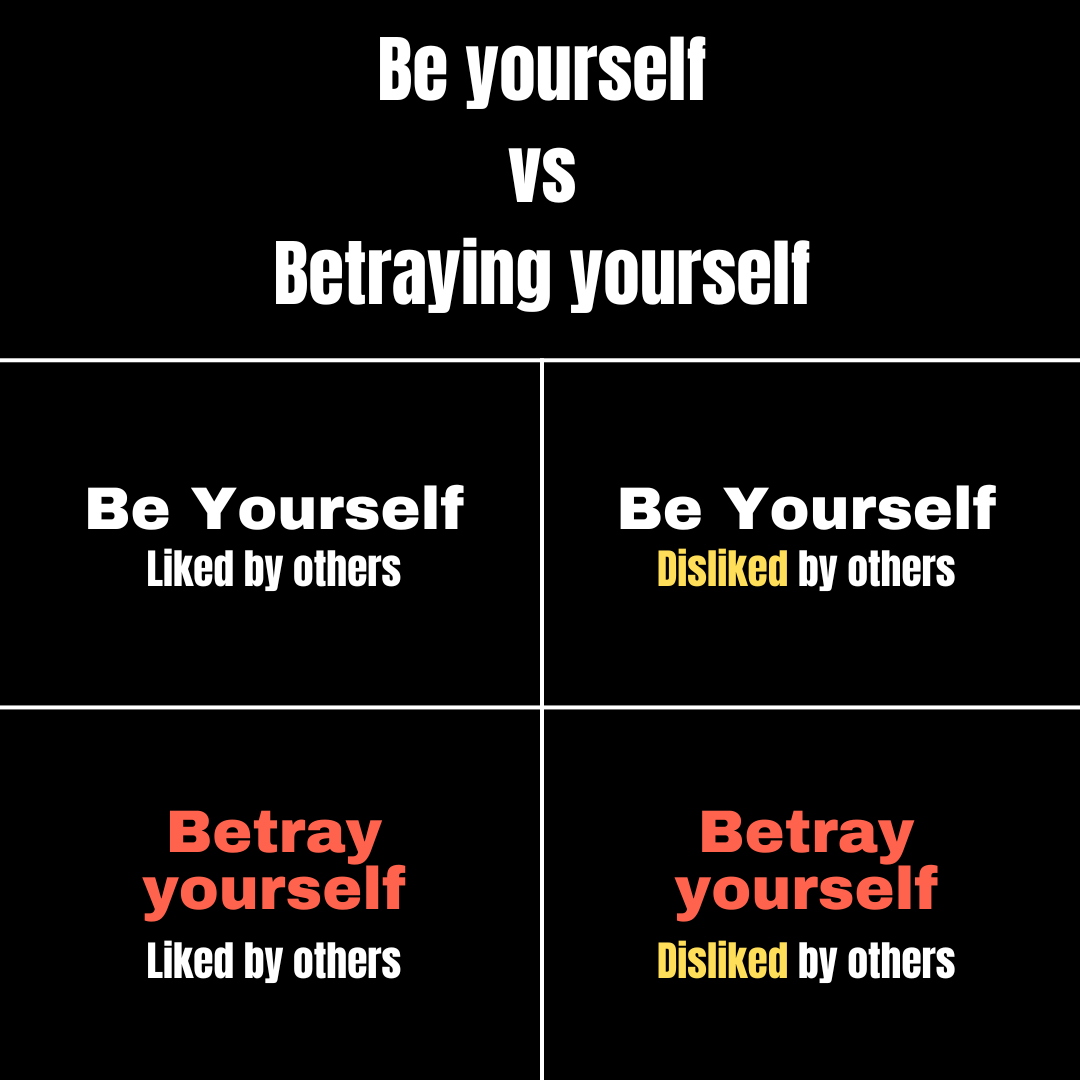
On being liked: Being yourself vs betraying yourself. A four quadrant analysis
All the time, we all hear the following: “Just be yourself.” On the whole, I concede that these words form sage and sound advice. In fact, as someone who historically shaped shifted throughout his life in order to conform to social expectations, I mindfully practice being myself every day.
The act of being oneself is a topic over the past six months occupies a large portion of my mental real estate. Because I’m interested in this topic, I fall victim to Baader-Meinhof phenomenon (i.e. frequency bias), my attention antennae keep gravitating towards discussion where the topic of “being oneself” centers the conversation.
In fact, this entire post was motivated by a podcast episode (from The Capsule, a London based dance podcast) revolving around sports psychology performance. During that episode, the guest (Jo-L) shares his perspective on having the choice to be yourself:
“You can make a choice … People are going to love you for everything that you are … and everything you want to be … [or] they are going to hate you for that. Then, on the other hand, there are going to be like hating you for all the things that you are not, as in that you pretend to be. So like, essentially speaking, you’re making the choice between like …. you’re going to be loved or hated anyway, so you might as well be loved for the things that you wanted to be loved for.”
In response to this, the podcast host points out even a more subtle, more dangerous aspect to what I’m going to call betraying yourself.
“… or even worst, lose [a dance battle] cause of who I am not. Imagine changing your whole dance because that’s the RIGHT thing to do or the RIGHT way of dancing”.
Overall, I agree and I myself will continue biasing towards just being myself.
However, my curious nature wanted to dig into the notion of betraying yourself (i.e. “not being yourself”) and how I consider it to be quite a seductive position. Because there will be moments in which you betray yourself. Because there are moments when you will be rewarded in the form of praises from others.
According to Chase Jarvis, he believes this constant betrayal happens to all of us:
“We will all betray ourselves over and over again and the goal is to just do so slightly less and return to ourselves with a little more kindness and a little more awareness and get 1 percent better every day … the person who is a degree off who walks a thousand miles”
With that in mind, let’s compare being yourself versus betraying yourself.
Be yourself
When you just show up as who you are, you might be liked by others. This quadrant, to me, is the ideal condition, wouldn’t you say? There’s no performing. You spend little cycles taking the temperature of the room. You spend less time evaluating body language and attuning to facial micro expressions. You are doing what dialectical behavior therapy calls participating, mindfully being in the moment.
Of course, when you are being yourself, you may be disliked by others. This is inevitable, considering there are over 8 billion people occupying this earth. How could any one person be liked by everyone? That’s statistically impossible. Furthermore, every individual person on this earth is unique, according to Reiss Motivation Profile, which posits that though we are all motivated by the same 16 basic human desires, how much we’re motivated by each value differs.

Betraying yourself
On the whole, betraying yourself is more or less “masking”, being someone you are not. At the risk of being overly understanding (is that even possible), we all do this, according to Chase Jarvis
“We will all betray ourselves over and over again and the goal is to just do so slightly less and return to ourselves with a little more kindness and a little more awareness and get 1 percent better every day … the person who is a degree off who walks a thousand miles”
Now, betraying yourself can be effective (and dare I say, useful) in certain contexts. For me, personally, assuming we all betray ourselves on and off throughout the course of our life, I want to both give latitude to myself and increase my awareness when this betrayal occurs.
Though we can betray ourselves in the short term, it is not, according to sports Psychologist Michael Gervais, unsustainable in the long term.
“You contort to fit in. You sacrifice authentic expression on the altar of approval. You twist yourself into a shape that appears socially acceptable but it’s performative in nature. The response does not represent your authentic self. Contorting creates a temporary relief but leaves you feeling disconnected from others. Because you don’t share your true self, you never feel connected, understood, or embraced, nor do you become a trusted member of the community. By pretending to be someone you’re not, you constantly feel the pressure to maintain the facade. This can intensity the feelings of insecurity and fear of exposure.” (pg. 40; Gervais: First Rule of Mastery)
Now, what about betraying yourself and being disliked by others? If being yourself and being like by others is the most ideal quadrant, then betraying yourself and being disliked is the least ideal, the most disappointing. The possibility of this happening sufficiently motivates me to shy away from this behavior: what a slap in the face to pretend to be someone you are not, only to be rejected?
Summary
So, armed with this information, how do I want to approach my life from this point? These days, I tend to choose “Be Yourself”. I’m someone who values high degrees of acceptance (i.e. two standard deviations from the norm).
I will end this post with a little snippet from Steve Job’s commencement speech, which I’ve been memorizing and rehearsing daily, as if it were my own personal mantra. I wake up in the morning, verbally recall these words, and then from memory, try and write down these words. For me, it is one of the ways I am practicing a stoic approach to living:
“Remembering that I’ll be dead soon is the most important tool I’ve ever encountered to help me make big choices in life. Because almost everything — all external expectations, all pride, all fear of embarrassment or failure — these things just fall away in the face of death, leaving only what’s truly important. Remembering that you’re going to die is the best way I know to avoid the trap of thinking you have something to lose. You’re already naked. There’s no reason not to follow your heart …
Your time is limited, so don’t go wasting it living someone else’s life. Don’t be trapped by dogma — which is living with the results of other people’s thinking. Don’t let the noise of other people’s opinions drown your inner voice. And most important, have the courage to follow your heart and intuition. They somehow already know what you truly to become. Everything else is secondary”
-
Harry Mack on mastery, art of practicing, and flow state
I recently listened to a podcast episode by Harry Mack — a very gifted freestyle rap artist — named “Flow State” and I want to share a few key insights I took away regarding the art of practice. Though the discussion around his beliefs and advice revolve around freestyle rapping, I believe the principles can be more generally applied to other areas of life (e.g. dance) and ultimately, I think he’s ultimately describing mastery.
Harry Mack Podcast Snippet (60 seconds) recapping mastery Some background: like many others, I like to think that I am someone who values process vs results. Though hitting objectives and reaching goals are important, especially in certain contexts, I stay rooted in the art of mastery in both my personal and professional pursuits. These days, given dance is at the forefront of my life, I’m less concerned about winning a dance battle and more concerned with exploring my mind and body during a performance:
- What am I feeling?
- What are my thoughts?
Together, these two help gain more self-awareness, help me better understand WHO I AM and help me better align myself with WHO I WANT TO BECOME.
Similarly, on a professional level, these days I’m less concerned with my title and role (something I used to obsess over) and more with what the day to day responsibilities include.
Now, I’ve been interested in the topic of practice and mastery for over a decade; according to my Amazon purchase history, I bought the book “Talent is overrated” and “Mastery: The Keys to Success and Long-Term Fulfillment.” It’s a topic that I find myself gravitating towards on a daily basis.
Okay, enough background. Let’s get into it.
Main Take Away
Harry Mack transferred his knowledge of practice — he’s been playing music since he was 7 — and applied mastery to freestyle rap.
What practicing is NOT: just doing the activity
Here’s a common misconception when it comes to practice: just do the activity (e.g. dance, play the instrument) itself. Nope. That is NOT practice. While Harry Mack concedes that doing the activity itself will improve you skills and will help you ascend to a higher level, performing the activity is insufficient to reach what he considers an elite level. To reach an elite level, one must devote time to actual practice.
So what is it?
What is practicing?
Practice is about identifying your weakness and is more or less fairly regimented. A subtle (but what I consider important) point he makes is that the activity should feel fun and that you are more or less “creating little games for yourself … that are aimed at specific weaknesses so that you can improve upon them.”
I apply this concept of practice to my dance journey. One (of many) area of weaknesses that I’m aware of is my lack of coordination to intentionally perform polyrhythms: move two (or more) body parts at different rhythms. Most recently, I am working on polyrhythm that consists of 1) The cross step 2) Head isolation and 3) Arm movement. Though the integration of all three is what I’m trying to accomplish, I am breaking it down in parts that are manageable and within the range of my abilities. Harry Mack underscores the importance of making the exercises tailor fit for yourself:
“If you are not able to achieve the goal at a decent percentage, you need to slow down, shaving away excess, so you get right to the thing that you’re working on.”
Harry Mack’s example of practicing triplets
His practice is not something he would not typically do in front of others because practice seems rather mundane and he believes (though I disagree here) that his audience would not find it entertaining or engaging.
An example of practice (for him) is triplet rhythms, with one syllable rhymes. The practice would be him rapping four bars:
Off of the top I get in the zone.
I’m on the one I’m never no clone.
I do my bars direct off the dome.
I send these rappers all the way home
He’d perform this exercise for 20 minutes and reminds the listeners of the podcast that the practice is NOT a performance.
Performance: where the rubber meets the road
As mentioned above, practice is highly regimented with clear parameters. When it comes to performing (in front of others), Harry Mack offloads all the regimented practice, letting it all go: “[Performance is] bringing everything together in real time without the regimented structure and there are no rules”
Summary
Ultimately, to practice, you want to come up with your own exercises that:
- Get you into a flow state
- Match your current skill level
Flow state is not about repeatedly doing something easy. It’s a meditative state.
In fact, it’s about “doing the thing that is at the razor’s edge of your ability …. we can make practice fun; don’t bite off more than you can chew. The surest way that practice doesn’t feel flowy and fun is try to do something that’s way outside your ability and you’re just fucking up the whole time.”
If you are tripping up, try slowing it down, making it easier somehow, or reducing scope.
-
House Dance Private with Ani
I took a private house dance lesson with Ani and below is a 30 second clip condensed version of our 1 hour private. I had originally reached out to her and asked for a private lesson after struggling in her House Beginner/Intermediate class. In particular, I fumbled with the pas de bourree torso isolation as well as some other grooves that she helped break down. The lesson itself took place at Central Saint Martins (CSM) in London. This was my first lesson that took place outdoors, in public. At first, I felt a bit shy and nervous, since tourists and people in general would walk past by us. But after the first couple minutes, the anxiety wore off and the rest of the private lesson was amazing.
-
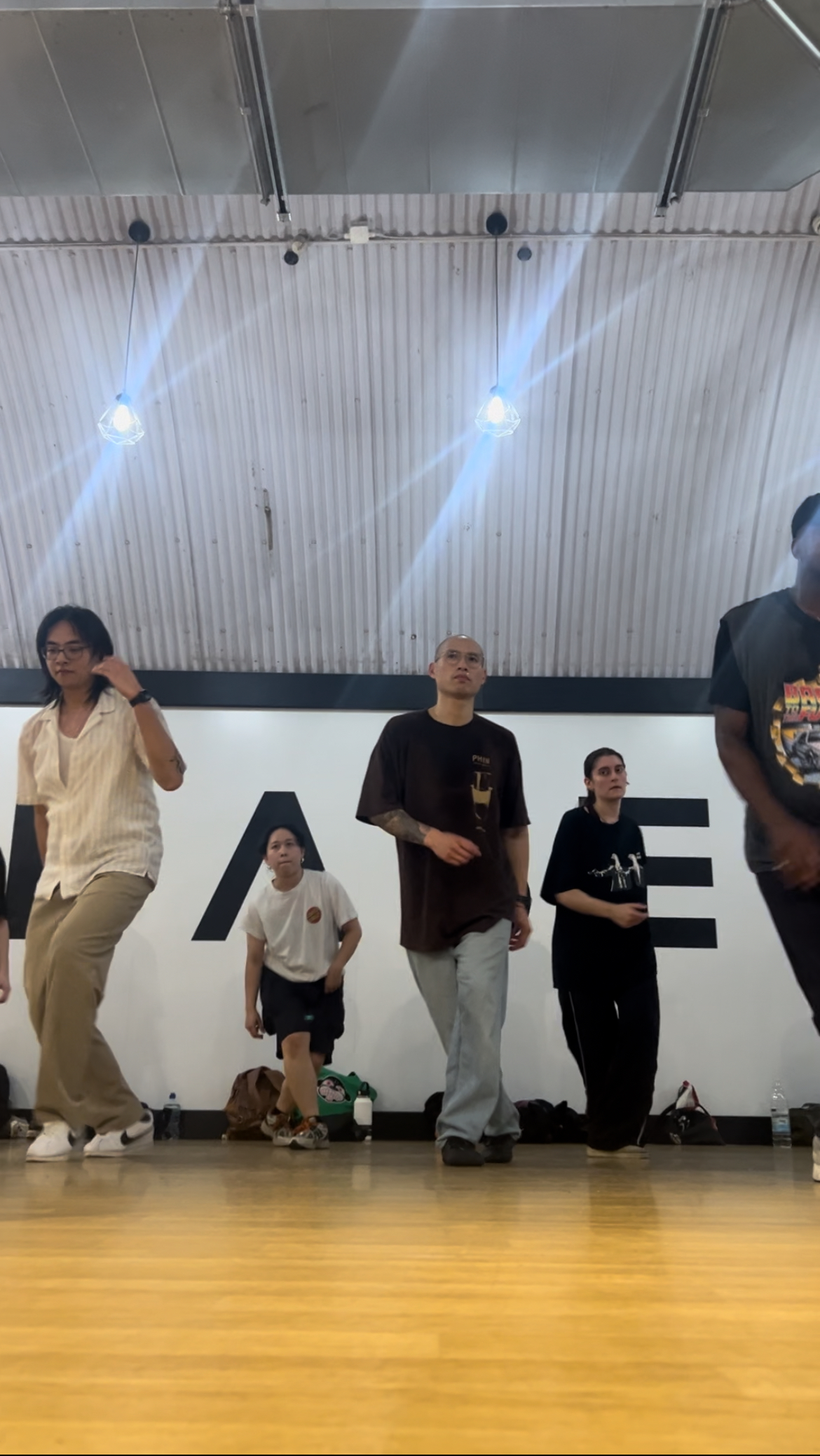
House Dance Reflection and Review: Jevan (August 15, 2024)
Took the class yesterday night and while still fresh in my mind, brain dumping.
Best part of the class for me was witnessing my freestyle classmate light up with joy midway through her freestyle round when she went for a move, caught a groove, and her face beamed up.
Note: As usual, I’m recalling the choreography from memory and there are details missing including the counts, how the moves relates to the music (big component), and so forth.
Right kick and slide back
Left kick and slide back
Right kick and drag to the right
Left kick and drag to the left
Cross step variation to the left
Cross step variation to the right
Cross step (no variation) to the left
Cross step (no variation) to the right
Right kick and slide back
Left kick and slide back
Right kick and drag to the right
Left kick and drag to the left
Cross step variation to the left
Cross step variation to the right
Cross step (no variation) to the left
Cross step (no variation) to the right
Misdirection to the right
Misdirection to the left
Misdirection to the right
Jump and step to the right
Step on to left foot and rebound
Roger Rabbit like transition to the left and reboundAreas of growth
Below are areas in which I felt challenged and would like to drill a bit more
- A little bit of dinosaur arms during the kick and slide – felt tense in the anterior part of shoulder and forearm(s) when sliding back and sliding side to side
- Foot steps for the misdirection – was unable to land the prescribed landing
- Rebound – was unsure if it was just the shoulders turning or the entire torso
- Cross step variation – cross step variation differs in two ways. normal cross step (when going to the left) is left leg step to the side, right leg step back, left leg cross over in front to the right. For the variation (to the left) left leg step to side, right leg step forward (NOT back), left leg step BEHIND
Takeaways and observations
- Jevan’s back leg bent and knee tucked behind one another during cross step
- Increase awareness of torso positioning difference between cross step vs cross step variation (i.e. stepping forward) – Jevan had pointed out that center of weight is slightly leaned back during the variation, whereas center of weight slightly more forward during non-variation
-
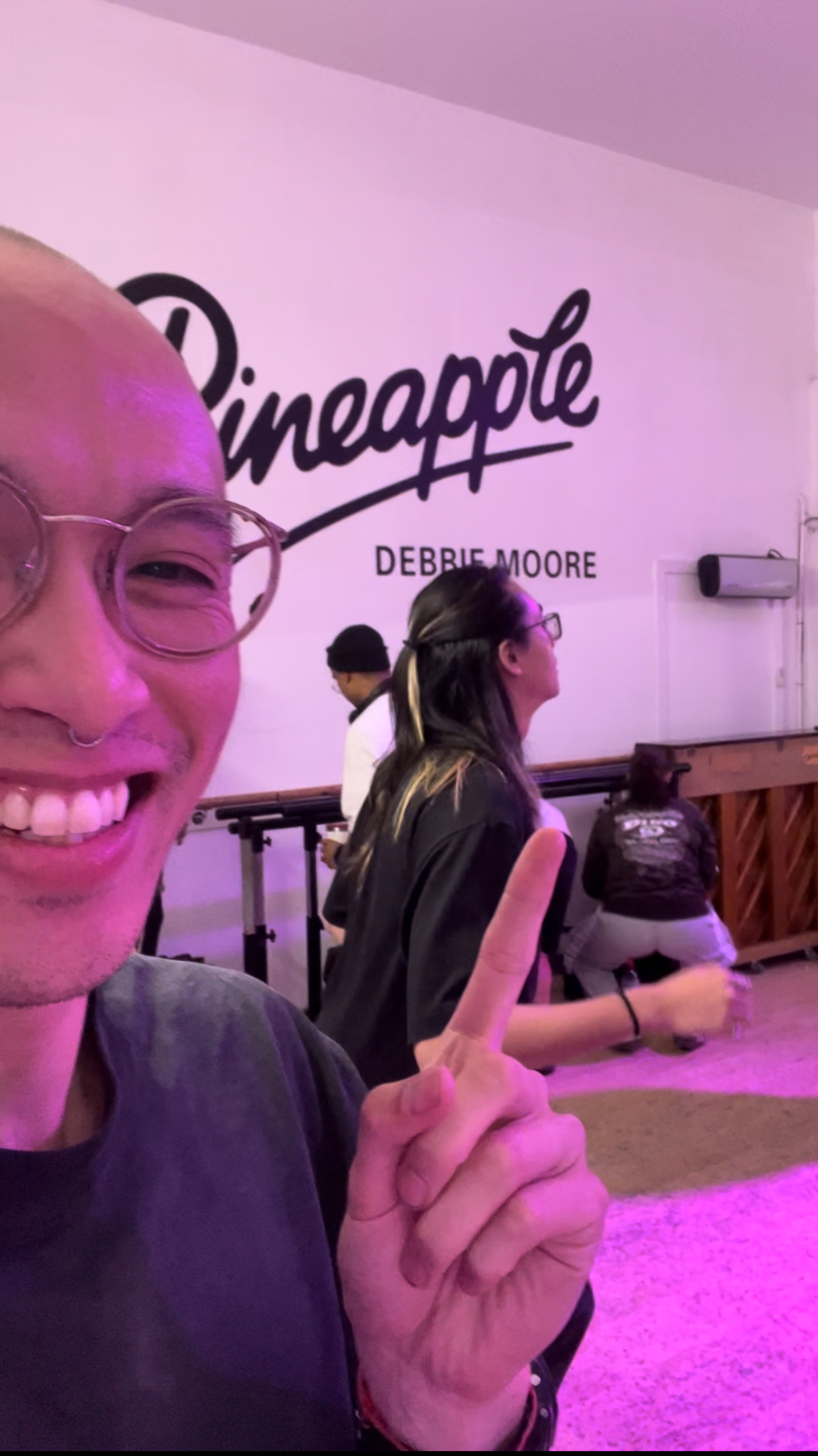
House Dance Class (August 13, 2024) – Review and Reflection
Below is a short review and recap of Ani’s house dance class (beginner/intermediate) that takes place in London every Tuesday night at 6:00pm over at Pineapple Studio. Though I enjoy taking this class every Tuesday, this instance of the class was special because my friend Will (from Seattle, who was visiting London) joined me and I felt so much joy to dance with a friend who I trained with back home.
Class Recap
- Warm up with foundational move (Jack) and other foundations
- Practice several combos that are part of larger choreography
- Freestyle Exercise (Rhythm based) with partner
- Choreography – Difficulty for me was 6.8 / 10
Freestyle Exercise
In terms of difficulty, I found this exercise 10/10. I struggled and fumbled hard, since its really one of the first times I was consciously trying to dance to a different, prescribed rhythm. Normally, whenever I freestyle, I just kind of go rogue and do whatever I feel like. Of course, sometimes that’s totally normal, especially in a social dance scene (e.g. clubbing). However, consciously dancing to a particular rhythm requires a totally different set of skills. This deliberate practice of dancing to a specific rhythm (see below) tripped me up and for the first few rounds and all I was sustain throughout the exercise was more or less stepping in place and even that in itself overwhelmed me.
The count itself was as follows:
1 2 – +4 5+ 6+ 7 8
Separately, as a result of the frustration I felt during the class, the next morning when I woke up, I ended downloading, installing, and learning Music Score to reproduce the rhythm (this in itself was good practice) and slapped my hands together (more on this in a different blog post).
Choreography
This section serves several purposes.
First, allows me to practice my mental recall. I’m about 4 months into taking choreography classes and my retention is slowly improving. When I took my first choreo class back in April, I fumbled and could barely retain anymore than 2 eight counts and I remembering feeling so frustrating during that first class and a level of resignation.
Second, when I want to refer back to this choreo and practice it, I can. Despite the written choreo below not being precise, I believe that I will be able to practice so as long as its accompanied with the video (below).
So be forewarned, the choreography is not completely accurate and fails to include the counts. That being said, here it is:
Shuffle variation (left side)
Pow wow to the front
Pow wow to the back
Shuffle variation (again) left side
Pow wow to the front – slight variation here and instead of kicking out right leg stick it to the ground and reduce the count
Tap the right foot
Drag – left leg around and hold for 2 counts
Step left foot out
Get into farmer position with right leg bent
Tilt the right hip out and forward – at the same time, shift body weight leftwards back
Return and neutral position
Step right leg back
Step left foot back and toe tapTransition into squat position
Spin left
Land in pas de bourree position
Pas de bourree to the right but kick out with the left foot
Land and transition into loose leg
Loose leg with jump kick variation (right side)
Loose leg with variation (see new moves section below)
Loose leg with variation to the right
Continue pivoting on right foot for rest of the count
Jack for four bars (i.e. 2 eight counts)
Heel Toe right side
Heel Toe right side
Heel Toe left side (with head tilt)
Heel Toe left sideAreas I want to practice
- (Continue to) Increase Hip Extension mobility – I felt tight in this line, especially when kicking the leg behind me
- Spin move itself – When Ani was spinning, I noticed how her left leg (right leg was the base we were spinning on) was bent at a clean 90 degree angle and left knee cap was tucked behind her right knee cap
- Spin transitition into the pas de bourree position
- Heel Toe with head tilt – could not land this during class and could line up the counts
- Loose leg variation with pivoting on base leg – this was a variation I’ve never seen before and I really enjoyed the smoothness and aesthetic of it
-
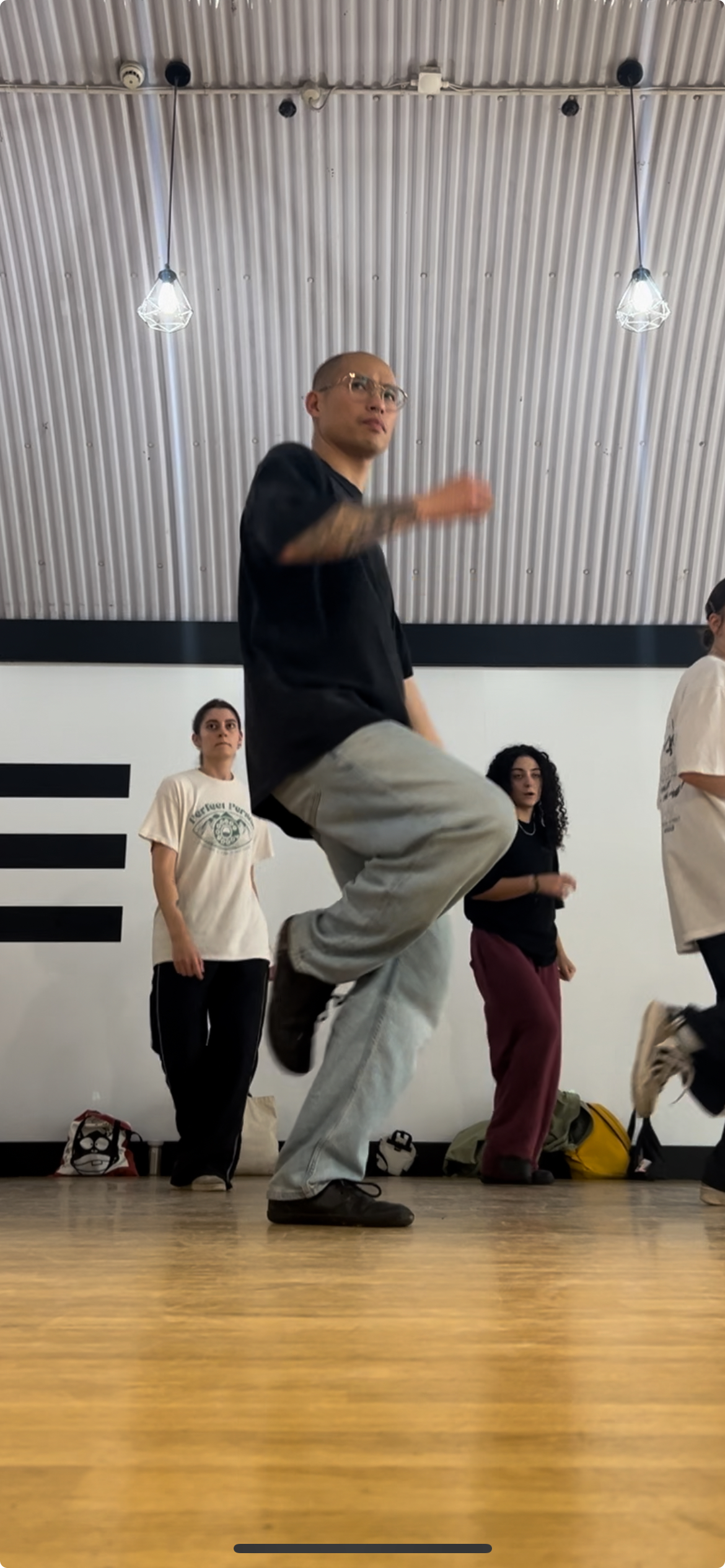
House Dance Class Recap – Review and Reflection
Class Details
Location: Base Dance Studios (in London, by Vauxhall station)
Date/Time: August 08, 2024 @ 5:30pm-6:55pm (85 minutes)
Overall class difficulty: 5 out of 10
Combo difficulty: 6 out of 10
Freestyle exercise? YesOverview
This blog post serves multiple purposes.
First, it helps me experience gratitude. Attending this class is one of the ways I squeeze in (my low desire of) socializing with folks who share similar values (e.g. physical activity, curiosity, social contact)
Second, the post may motivate someone to take the class and perhaps they are on the fence and want to gain a little insight into what will be learned.
Third, this post is a form of reflection, allowing me to contemplate what moves and exercises I want to continue practicing.
The class agenda was as follows:
- Warm up – often my favorite part of the class and I incorporate the moves into my freestyle rounds
- Short combination – consisted of the chase, loose legs, dodger, former, tic tac toe (variation) and side walk (variation)
- Freestyle partner exercise – each of us took turns with the (above) combination
- Cypher – we formed a larger circle (still only consisting of 4 individuals) and exchanged with one another
To get a glimpse of what the class looked like, here’s a little reel I put together that’s part and parcel of my dance journey log.
Combo: Chase, Loose Legs, Farmer, Dodger, Tic Tac Toe, Side Walk
Overall, I felt the difficulty of the combo was 6 out of 10. The reason for the somewhat higher than average difficulty is because I was unfamiliar with the tic tac toe and side walk variation. Outside of these two moves, I was familiar with the other foundational moves (e.g. chase, loose legs, farmer).
Combo Breakdown
Chase (right)
Chase (left)
Chase (right)
Chase (left)Loose leg (right)
Loose leg (left)
Loose leg (right)
Loose leg (left)Dodger (left)
Dodger (right)
Dodger (left)
Dodger (right)Farmer (right)
Farmer (left)
Farmer (right)
Farmer (left)
Farmer (right)
Farmer (left)
Farmer (right)
Farmer (left)Farmer variation syncopated (right)
Farmer variation syncopated (left)Tic Tac Toe variation (right)
Tic Tac Toe variation (left)Side walk variation (left)
Side walk variation (right)Areas of growth
As mentioned above, classes reveal what areas I’d like to work on (there are many). Here are the ones that I struggled with:
- Tic Tac Toe – Not only was the positioning of the feet challenging, but the groove and body positioning felt foreign
- Transition from dodger (last one) to the tic tac toe – while the dodger move itself was not challenging, theh transition out of this move INTO the tic tac toe tripped me up
- The side walk variation – Jevan loves this move and it’s a variation that I haven’t been able to stick for months. In fact, I struggle with this almost every class in which this move is part of the combo. My body is accustomed to a familiar move: the pow wow. That move has been committed to muscle memory so my body wants to default to the pow wow.
- The farmer – Though it is considered foundational and something I’ve thrown in rounds before, I’m not quite confident with the timing and feels a bit “off beat”
- Syncopated Loose Leg – fan of this variation that he introduced, the first time I’ve danced the move
Freestyle exercise
The freestyle exercise was essentially partnering up with one other person in class and each of us taking turns to perform the freestyle.
After each of performed our combo, our partner would then offer
- A positive comment pointing out what they liked out of round and
- An area of growth.
For me, the positive comment I received was that my loose legs were the “loosest loose legs” and that it was sublime. For the area of growth, she pointed out my farmer. Though she wasn’t able to precisely offer feedback, I felt even within my body that I was not stretching out the entire downbeat.
Closing – dancing for others AND dancing for self
In a nutshell, you can BOTH dance (for yourself) and perform (for others) — at the same time.
Most of the classes I’ve taken in the United States emphasize that house is a feeling. Instructors often encourage students to NOT perform and instead, dance … to be free. While this belief resonates with me, I find that this assertion can sometimes unintentionally invalidate another aspect of dance: performing.
What I appreciated about what Jevan said was that freestyling is both dancing for yourself AND a performance. I believe the two — dancing for self and dancing for otthers — can (and do) co-exist.
Sometimes I dance without the idea of performance and consider these times rare, consider them “catching the ghost”. Othertimes I’m a bit too in my mind and I find that I am performing. Often, it’s a combination of dancing for self AND for others.
-

Top 5 Zettelkasten.de forum posts
I’m obsessed with personal information management (PIM) and as I learn more about the discipline, one concept continues to repeatedly crop up: Zettelkasten. I first learned about Zettelkasten after reading one of my favorite books “How to take smart notes”, and since then, I’m sold on the idea and continue to tweak my digital workflow and draw inspiration from the online Zettelkasten community at Zettelkasten.de. This online forum, like many other online communities, buries tons of gems hidden within the conversation threads.
At the time of this writing, the forum paginates across 43 pages, each page containing one or more forum posts, each post potentially containing nuggets of gold. But because I’m short on time, I really only want to read the top discussions. Unfortunately, there’s no easy or built in way to sort those posts so I wrote a little script that identifies the top posts by view count. Below are the top 5.
Top 5 Forum Posts
Below are the top 5 forum posts from Zettelkasten.de, sorted by views in descending order.
- The Collector’s Fallacy (25,300 views)
- Create Zettel from Reading Notes According to the Principle of Atomicity (23,300 views)
- A Tale of Complexity – Structural Layers in Note Taking (21,500 views)
- You Only Find What You Have Identified (21,200 views)
- The Difference Between Good and Bad Tags (16,100 views)
Programmatically retrieving view counts
This section describes how I used a combination of bash and python to fetch the view counts on the forum. The actual (python) code for parsing the pages themselves can be found in my public github repository hosting my random one off scripts.
- Fetch all the forum posts with curl
- Save HTML to disk
- Write a little python parser that extracts the view count
- Output a comma separated value (CSV)
- Use sort followed by with head
[code lang=”bash”]
% for page_num in $(seq 1 42);
do curl "https://forum.zettelkasten.de/discussions/p$page_num -O ;
done
[/code]

